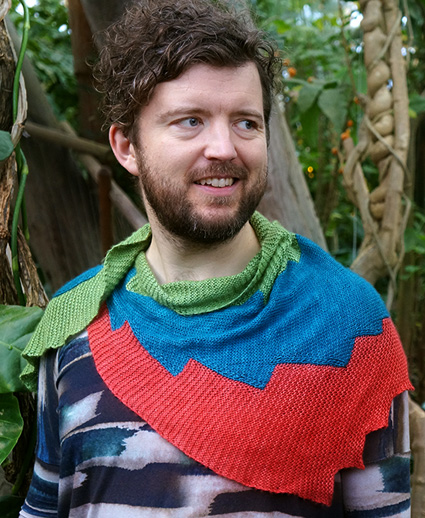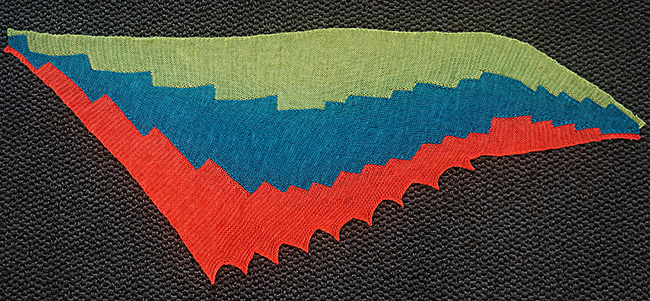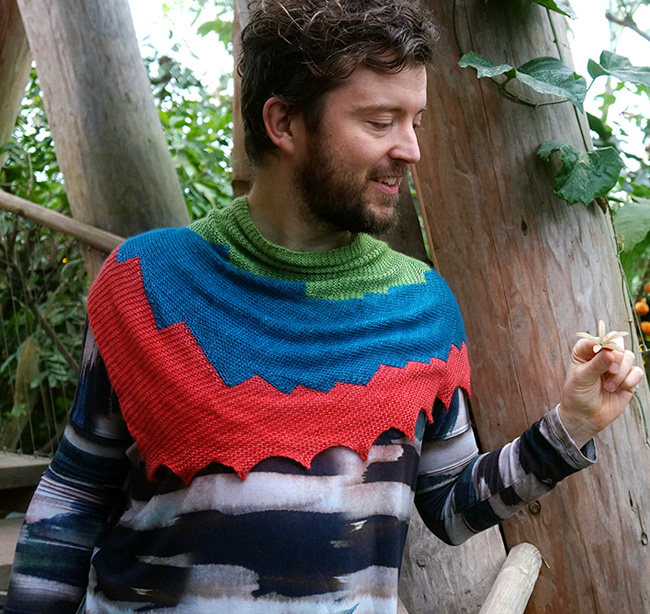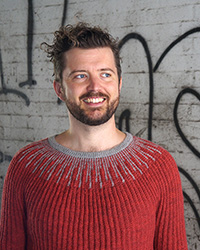Brightstairs, a free knitting pattern from Knitty.com. Free knitting pattern for an Intarsia shawl with a stepped color pattern.
INTRODUCTION
Brightstairs
 by vithard | prince of knitting
by vithard | prince of knitting
![]()
Sometimes the display of the yarn at the store is enough inspiration. The three colors shouldn’t be mixed, but displayed in the shawl the same way, but using different techniques; a stockinette section, surrounded by two garter sections, one created by knit stitches and one created by purl stitches.
The yarn used for the sample is a lustrous cashmere/silk-blend, that is sooooofft, and drapes beautifully.
The shawl is worked from side to side in an intriguing pattern.
The pattern of the shawl consists of three and eights. Three colors, three stitches. Three at the beginning, three at the end.
Every time 8 stitches have been increased a new step appears. 8 is the number that shapes the stairs, and thereby the pattern and the shawl. The steps appear in the shapes of the color sections and along the side of the shawl.
The shawl is perfect around the neck or over your shoulders on chilly spring evenings.
 model: vithard
model: vithard
 photos: Claus Jørgensen
photos: Claus Jørgensen
SIZE
One
FINISHED MEASUREMENTS
Width: 49 inches/125 cm
Length: 18.5 inches/47 cm
MATERIALS
Yarn
Nature’s Luxury BLISS A*** [65% cashmere, 35% silk; 218 yd/200 m per 1.76 oz/50 g skein];
![]() [C1] Flamenco; 1 skein
[C1] Flamenco; 1 skein
![]() [C2] Baltikum; 1 skein
[C2] Baltikum; 1 skein
![]() [C3] Wiesengrund; 1 skein
[C3] Wiesengrund; 1 skein
Recommended needle size
[always use a needle size that gives you the gauge listed below - every knitter's gauge is unique]
![]() US #7/4.5mm circular needle, 32-40-inches/80-100cm long
US #7/4.5mm circular needle, 32-40-inches/80-100cm long
Notions
![]() yarn needle
yarn needle
GAUGE
23 sts/25 rows = 4 inches/10 cm in stockinette stitch after blocking
PATTERN NOTES
[Knitty's list of standard abbreviations and techniques can be found here.]
The shawl is worked using the intarsia technique, working each color in its own section.
Section 1 (with C1) is worked in garter stitch, knit all rows.
Section 2 (with C2) is worked in stockinette stitch, k on RS and p on WS.
Section 3 (with C3) is worked in garter stitch, purl all rows.
Twist the yarns around each other when you move from one section to the next.
DIRECTIONS

Triangular Section
Using the backwards loop method CO 3 sts with C1, 3 sts with C2 and 3 sts with C3.
Using the intarsia technique, shaping the 3 sections, work in this manner:
Row 1 [RS]: K3 with C1; k3 with C2; p3 with C3.
Row 2 [WS]: P3 with C3; p3 with C2; k3 with C1.
This sets the pattern for each section. For ease of reading, the instructions for the separate sections are separated by semi-colons.
Row 3 [RS]: With C1, k section 1; with C2, k1, m1r, k until 1 st of section rems, m1l, k1; with C3, p section 3. 2 sts increased in section 2.
Row 4 [WS]: With C3, p section 3; with C2, p section 2; with C1, k section 1.
Repeat Rows 3-4 three more times. 17 sts total: 3 in sections 1 and 3, 11 in section 2.
*Next row [RS]: With C1, k section 1; with C2, k section 2; with C3, p section 3.
Following row [WS]: With C3, p section 3; with C3, p first 8 sts of section 2, with C2, p rest of section; with C1, k section 1.
Work Rows 3-4 four times. 8 sts added to section 2.
Next row [RS]: With C1, k section 1; with C1, k first 8 sts of section 2, with C2, k rest of section; with C3, p section 3.
Following row [WS]: With C3, p section 3; with C2, p section 2; with C1, k section 1.
Work Rows 3-4 eight times. 16 sts added to section 2.
Repeat from * three more times, and work a fourth section until you have 43 sts in each section, ending with a WS row. (You will end after four of the eight repeats of Rows 3-4.)
Pointy part
Row 1 [RS]: With C1, k section 1; with C2, k section 2; with C3, p section 3.
Row 2 [WS]: With C3, p section 3; with C2, p section 2; with C1, k section 1.
Row 3: With C1, BO 8 sts, k rest of section 1; with C1, k first 4 sts of section 2, with C2, k rest of section; with C2, k first 4 sts of section 3, with C3, p rest of section.
Row 4: With C3, p section 3; with C2, p section 2; with C1, k section 1.
Rows 5-12: Repeat Rows 1-2 four times.
Rows 13-14: Repeat Rows 3-4.
Rows 15-22: Repeat Rows 1-2 four times.
Row 23: With C1, BO 8 sts, k rest of section 1; with C1, k first 8 sts of section 2, with C2, k rest of section; with C3, p section 3.
Row 24: With C3, p section 3; with C2, p section 2; with C1, k section 1.
Rows 25-32: Repeat Rows 1-2 four times.
Repeat Rows 3-32 until 57 sts remain (19 sts in each section), ending with Row 32.

Tip of shawl
Row 1 [RS]: With C1, k section 1; with C2, k1, ssk, k to last 3 sts of section 2, k2tog, k1; with C3, p section 3. 2 sts decreased in section 2.
Row 2 [WS]: With C3, p section 3; with C2, p section 2; with C1, k section 1.
Repeat Rows 1-2 three more times.
Row 9: With C1, k section 1; with C2, k section 2; with C2, k first 4 sts of section 3, with C3, p rest of section.
Row 10: With C3, p section 3; with C2, p section 2; with C2, p first 4 sts of section 1, with C1, k rest of section.
Repeat Rows 1-10 until 25 sts remain, then work Rows 1-8 once more. 17 sts total: 3 in sections 1 and 3, 11 in section 2.
Work Rows 1-6 again. 11 sts rem.
Next row [RS]: With C1, k section 1; with C2, k1, CDD, k1; with C3, p section 3. 9 sts.
Last row [WS]: With C3, p section 3; with C2, p section 2; with C1, k section 1.
Bind off all sts in the corresponding color.
FINISHING
Block and weave in ends.
ABOUT THE DESIGNER
 Vithard is a Danish knitwear designer and textile artist and he’s judge on the knitting tv-show, The Great Knit Off. He is known as the prince of knitting.
Vithard is a Danish knitwear designer and textile artist and he’s judge on the knitting tv-show, The Great Knit Off. He is known as the prince of knitting.
Vithard goes on exploration in a world inhabited by all kinds of fiber, to see how far, how much or how little they can do. To him, knitting is like playing, it’s an exploration of the expression of surfaces and materials. He tries to pass this curiosity on to the students of his workshops, the audience at his lectures or on TV.
Vithard teaches and gives lectures worldwide, and he sells his kits and patterns on Ravelry, Etsy and his website.
Pattern & images © 2017 vithard | prince of knitting. Contact Vithard